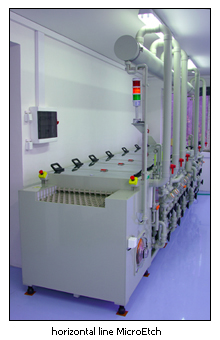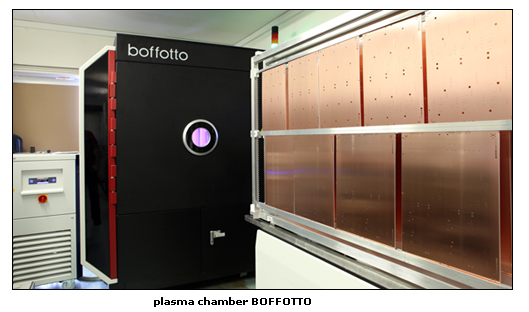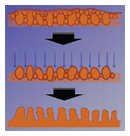- HOME
- Products
- Basic materials
- Technical conditions
- Technological equipment
- CAD CAM
- The Laser Photoplotter
- CNC drilling and routing
- UV Laser drilling and routing
- Laser Tannlin TX PROi
- Direct plating
- Vyplňování otvorů | Planarizer
- Surface readjustments
- Surface finishes
- Galvanic processes
- Digital Direct Imaging
- The etching
- Solder mask and silkscreen
- Inspections of PCB
- Controlled impedance
- Multilayer lamination
- Contour fabrication
- Analytical Laboratory
- PCB Designs
- PCB assembly
- Terms and Conditions
- Preislist
- Contact
- kariéra
Surface readjustments
Microetch
In last year, there is significant demand on the higher heat resistance of solder mask and also on better resistant against chemical processes. The main quality point with solder mask is its adhesion on copper foil. Adhesion is normally ensured by mechanical way -brushing or by chemical process – microetching. When brushing, copper foil is stressed and it is impossible to use this approach on thin boards. With increased demands on our production, especially on flex-rigid a flex boards, but also on inner-layers of multilayer boards, we decided to purchase chemical line for microetching. As a chemical process we chose system MECetchBOND from renowned company MEC. Our microetch line is made by well-proven company Lumiplas. Commissioning and parameters set-up was done without any problems and therefore is from 1.12.2009 in full operation.
 |

|
Plasma activation
Plasma is partially ionized gas consisting of ions, electrons, free radicals and neutral admixtures (molecules, atoms...) in various quantic states, whose spatial charge is approximately equal to zero. Plasma is also called the fourth state of matter. This mixture of ionized gases is conductive and highly reactive and it has a tendency to react with any material. This is precisely what provides the basic condition for plasma process used in the production of printed circuits. Plasma is capable of attacking even chemically inert materials; it is used for surface activation of materials on the basis of Teflon, for removal of smear of resin from drilled holes, for removal of epoxides and polyamides during the production of flexible circuits or Flex-Rigids.
A typical device for plasma production consists of four basic parts: vacuum chamber, electrodes, vacuum pump and RF source. In practise, a panel of printed circuits is placed between two electrodes, vacuum (200-300 mBar) is created in the chamber and afterwards it is filled up with gaseous mixture. Electrodes are excited by RF energy and this initiates the plasma. For individual applications, different composition and combination of basic gases N2, O2, CF4 and H2 is used. In the example we will demonstrate the process of the cycle for desmearing (removal of impurities on a board’s surface and removal of smear of resin from drilled holes). The board is placed between the electrodes and vacuum is created in the chamber. The first step is the combination of gases which heat up the boards to a higher temperature. The boards thus better react with the created plasma. The next step is addition of CF4 gas into the plasma chamber. In this moment the desmearing proper starts (removal of impurities) from the surface of the board and from the walls of the holes. The last process is to create plasma from pure O2 gas, which removes any rests of fly-ash or fluorine from the previous reactions.
 |
For the production of printed circuits from the materials on the basis of Teflon, high Tg materials, for the production of flexible circuits and Flex-Rigids, the use of plasma is the only reliable method. Removal of impurities and activation of a board’s surface and the inside of a drilled hole is not possible in chemical or other way. Since the plasma process is software-controlled, all the crucial parameters are observed. RF source, amount of gases and temperature are programmed in advance and thus the process is fully repeatable with the same values.



 company adress :
company adress : place of business :
place of business :



